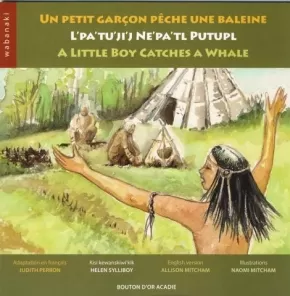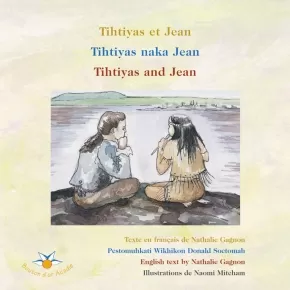Collection Wabanaki
Synopsis:
After creating the Mi’kmaqs, the great Glooscap was certain that he had established harmony on earth. But a problem remained: the beavers had built a huge dam across the Restigouche River, preventing the salmon from swimming upriver as far as the camp of the Mi’kmaqs who had come to fish there. Young Mi’kmaq men were convinced they could remedy the situation. However, completely failing to put things right, they asked the loon to call Glooscap to help them. Will the beavers once more outmaneuver Master Glooscap?
Educator Information
Delivered in a triple-language format of English, French, and Mi'kmaw.
Roy has written his version of a Mi’kmaq legend in this story, mentioning special places such as Sugarloaf Mountain.
French Text: Rejean Roy
English Text: Allison Mitcham
Kisi-Mi'kmaw wi'kek Text: Serena M. Sock
Illustrations: Rejean Roy
Additional Information
22 pages | 8.00" x 8.00"
Synopsis:
One late fall day, the boy told the old people that he was going fishing. When he returned home, he said that he had caught a whale.
Un matin, juste avant l’arrivée de l’hiver, le garçon dit à ses parents qu’il part à la pêche. Peu de temps après, il revient chez lui, tout heureux d’annoncer qu’il a pêché une baleine.
Educator & Series Information
This book is delivered in a triple-language format of English, French, and Mi'kmaq.
This book is part of Collection Wabanaki.
Synopsis:
How the Petitcodiac River Became Muddy is a trilingual picture book that retells a Mi'kmaq legend.
This simple story details the Mi'kmaq explanation for an eclipse, why the lobster turns red when it is put in boiling water, and how the Petitcodiac River became muddy long ago. This legend draws on the original version by Michael Francis (1923-1995) of Elsipogtog, New Brunswick. Glooscap figures prominently in this remarkable story that is recommended for language programs.
Educator & Series Information
The French title is Comment la riviÞre Petitcodiac devint boueuse. The Mi'kmaq title is Ta'n Tel-kisi-siskuapua'qsepp Petikotiak Sipu. Allison Mitcham tells the English version. Serena Sock provides the Mi'kmaq translation, and Marguerite Maillet provides the French translation. The dynamic art illustrations are created by Raymond Martin.
This book is part of Collection Wabanaki.
Additional Information
22 pages | 8.00" x 8.00"
Synopsis:
Tihtiyas and Jean is a trilingual picture book that retells a Passamaquoddy legend and also introduces the idea of contact with the French.
The French title is Tihtiyas et Jean. The English and French translation are provided by Nathalie Gagnon. The Passamaquoddy title is Tihtiyas naka Jean and is translated by Donald Soctomah.
The main character is a 12-year-old Passamaquoddy girl named Tihtiyas. She lives with her extended family near the mouth of the Schoodic River. One day she retells her younger brother the traditional story about Glooscap and Wuchowsen, the Wind-blower. This story explains why the waters are never too rough or too calm when the people fish. While telling this story both children see something in the distance that reminds them of the Wind-blower. They are amazed to see a large boat with white sails approaching the shore. From the boat, men with strange appearance come ashore and speak in a language they do not understand. This marks the contact period between the Passamaquoddy and the French. The girl meets a youth, named Jean, about her age and they share their love of music with each other. The French find themselves without much food and extreme illness over the winter as they settled on Muttoneguis Island (Saint Croix). But their neighbours the Passamaquoddy arrive to bring medicine and nourishing food.
This is a unique story that explores the contact period from the perspective of First Nation children. It also introduces young readers to the Passamaquoddy language.
Educator Information
This book is delivered in a triple-language format of English, French, and Passamaquoddy.
Additional Information
34 pages | 8.00" x 8.00"










